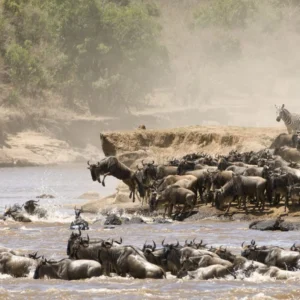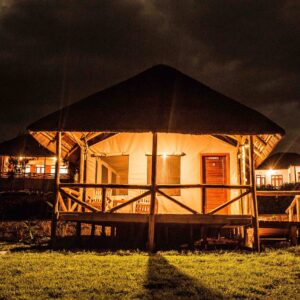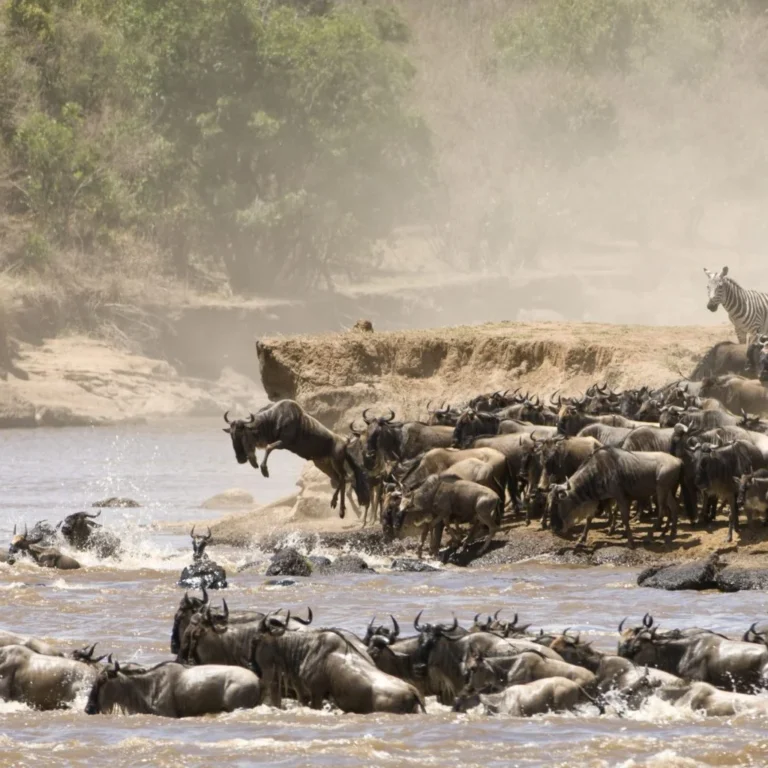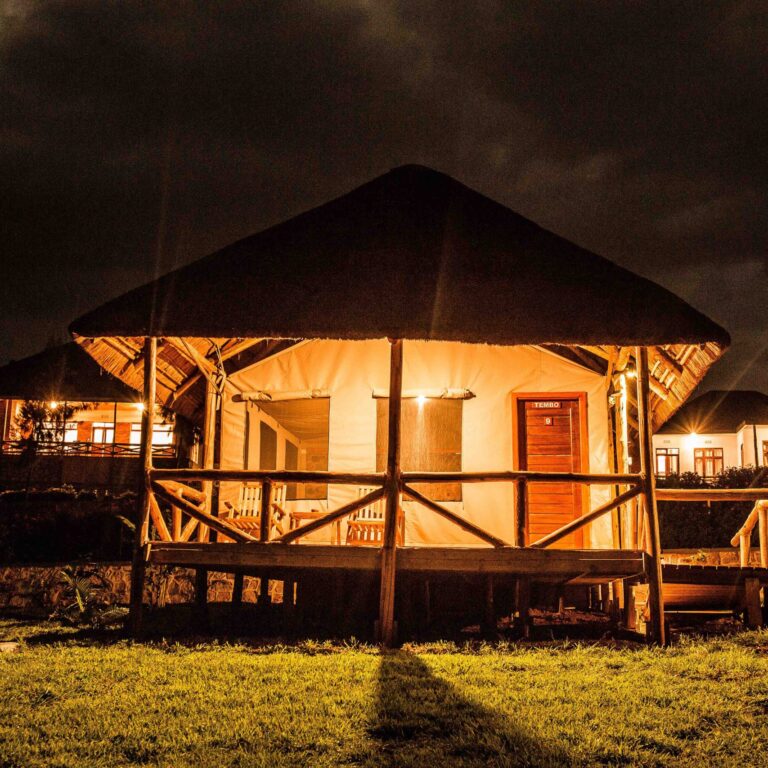Tanzania, a land etched into the global imagination by its iconic wildlife, dramatic landscapes, and vibrant cultures, is a country that truly lives up to its reputation as the “Soul of Africa.” Beyond the breathtaking safari brochures, Tanzania holds a treasure trove of fascinating facts that underscore its unique place on the planet – a destination that continuously surprises and delights even the most seasoned travelers.
A fascinating fact about Tanzania safaris is that the country hosts the Great Migration, the largest terrestrial animal migration on Earth. Millions of wildebeest, zebras, and gazelles traverse the Serengeti and Maasai Mara ecosystems in search of food and water. These amazing Facts About Tanzania’s spectacular event draw large crowds of tourists annually. From ancient human origins to geological wonders and rich cultural tapestries, here are some truly amazing facts about Tanzania that highlight its unparalleled grandeur and profound significance.
1. Mount Kilimanjaro: Africa’s Majestic Crown
Tanzania is home to Mount Kilimanjaro, not only the highest peak in Africa but also the world’s tallest free-standing mountain. Rising majestically to 5,895 meters (19,341 ft) from the plains, this dormant volcano is a geological marvel. Its iconic snow-capped summit, even near the equator, offers a challenging yet achievable trekking adventure. Drawing thousands of climbers each year to experience its five distinct ecological zones, from tropical rainforest to arctic conditions.
2. The Great Wildebeest Migration: Nature’s Grandest Show
The plains of Serengeti National Park host the most spectacular wildlife event on Earth, fun facts about Tanzania (read before you visit), about the Great Wildebeest Migration. Each year, over two million wildebeest, zebras, and gazelles embark on a perilous journey. Cyclical journey in search of fresh grazing and water. This relentless movement, a raw display of life, death, and survival, includes dramatic river crossings where crocodiles lie in wait, and mass calving seasons where hundreds of thousands of new lives begin. It’s a natural phenomenon of immense scale and emotional power.
3. Ngorongoro Crater: A Teeming Wildlife Eden
Within Tanzania lies the Ngorongoro Crater, often hailed as the “Eighth Wonder of the World” and a UNESCO World Heritage Site. This immense, unbroken volcanic caldera acts as a natural enclosure. Creating a self-contained ecosystem where wildlife thrives in astonishing density, great facts about Tanzania’s Ngorongoro Crater. It’s one of the few places on Earth where you can realistically spot the entire Big Five (lion, leopard, elephant, rhino, buffalo) within a single day. The crater floor is a permanent oasis, supporting an incredible concentration of animals amidst breathtaking scenery.
4. Home to Tree-Climbing Lions: A Rare Sight
While lions are typically found on the ground, Tanzania is one of the few places where you might witness the rare and fascinating behavior of tree-climbing lions. These majestic predators are most famously seen lounging on the branches of acacia and fig trees in Lake Manyara National Park and, less frequently, in Ruaha National Park. The reasons for this peculiar habit are still debated among scientists. Ranging from escaping tsetse flies to avoiding the heat or observing prey, it, a truly unique safari sighting.
5. Olduvai Gorge: The Cradle of Mankind
Tanzania holds immense significance for understanding human origins. The Olduvai Gorge, located within the Ngorongoro Conservation Area. The paleoanthropological site of global importance. Often dubbed “The Cradle of Mankind,” this deep ravine has yielded some of the earliest evidence of human ancestors and their tools, dating back millions of years. Discoveries here, particularly by the Leakey family, have revolutionized our understanding of early human evolution.
6. Zanzibar and the Shortest War in History
The enchanting island of Zanzibar, part of Tanzania, holds a peculiar historical record. It was the site of the shortest war in history. The Anglo-Zanzibar War, fought on August 27, 1896, lasted a mere 38 to 45 minutes. The conflict arose after the death of the pro-British Sultan. When his successor, who was less favorable to British interests, took power. The British issued an ultimatum, which was ignored, leading to a swift naval bombardment and a decisive victory for the British.
7. Diverse Wildlife: Beyond the Big Names
While the Great Migration and Big Five draw headlines, Tanzania’s wildlife diversity extends far beyond. It boasts over 30% of Africa’s total large mammal population, including cheetahs, wild dogs, giraffes, zebras, and numerous antelope species. And an incredible array of primates, like chimpanzees and colobus monkeys. Its varying ecosystems, from vast savannas to dense forests and wetlands, support this extraordinary biodiversity.
8. Lake Tanganyika: The Second-Largest Lake in the World
Tanzania shares its western border with Lake Tanganyika, which holds several impressive records. It is the second-largest freshwater lake in the world by volume and depth (after Lake Baikal). And the longest freshwater lake in the world. Its immense size and ancient origins have led to the evolution of a unique aquatic ecosystem. Home to over 250 species of cichlid fish, nearly all of which are endemic to the lake.
9. Tanzania’s Unique Culture: A Vibrant Tapestry
Tanzania’s culture is a vibrant blend of over 120 ethnic groups, most notably the Maasai, Sukuma, Chagga, and Hadzabe. Each contributes unique traditions, languages, and customs. The unifying thread is Swahili (Kiswahili), the national language. Which acts as a lingua franca across the country and much of East Africa. This linguistic and ethnic diversity creates a rich cultural tapestry. Reflected in its art, music, food, and daily life.
10. Tanzania is Safer Than Many More Developed Countries (for Tourists)
While perceptions of safety in Africa can vary, Tanzania is generally considered a very safe destination for tourists. Often surprises visitors with its tranquility and low crime rates in tourist areas. The robust tourism infrastructure, professional guides. The warm, welcoming nature of its people contributes to a secure travel experience. While common-sense precautions are always advised, visitors often feel more at ease in Tanzania’s safari parks and major tourist hubs than in some urban areas of more developed nations.
11. Nearly 30% of Tanzania’s Territory is covered by Protected Wildlife Zones
Tanzania demonstrates an extraordinary commitment to conservation. Approximately 28% (nearly one-third) of the country’s land area is designated for wildlife protection. Encompassing national parks, game reserves, and conservation areas. This vast network of protected zones ensures the long-term survival of its unparalleled biodiversity and allows natural ecological processes, like the Great Migration, to continue uninterrupted.
12. Over 120 Languages and Numerous Native Religions
Reflecting its incredible ethnic diversity, Tanzania is a linguistic and religious melting pot. It boasts over 120 different languages, making it one of the most linguistically diverse countries in Africa. While Swahili and English are official languages. Fun facts about Tanzania culture, a local communities often maintain its ancestral tongue. Alongside Christianity and Islam, numerous indigenous religions and spiritual practices flourish. Adding to the country’s rich cultural complexity and tolerance, Tanzania safari facts.
13. Tanzania Has Its Own Lost “Atlantis”
Deep within the waters of Lake Tanganyika, off Tanzania’s shores, lie intriguing submerged ruins that some locals refer to as Tanzania’s own “Lost Atlantis.” These include ancient stone structures and settlements, believed to have been submerged over centuries due to rising water levels. While not a lost continent. These underwater archaeological sites offer a glimpse into ancient human habitation along the lake’s shores, adding a mysterious allure to Tanzania’s history.
14. It Has Some of the Most Beautiful Waterfalls in Africa
Beyond its iconic plains and mountains, Tanzania is home to stunning natural beauty. Including several breathtaking waterfalls. From the lush slopes of Kilimanjaro, where the Materuni Waterfall plunges dramatically. Offering refreshing pools for swimming, to the remote and powerful falls found in more untouched regions, Tanzania’s waterways carve out incredible cascades. These hidden gems provide serene and picturesque escapes, often accompanied by vibrant green surroundings.
15. Zanzibar Was the Center of the Arab Slave Trade
Zanzibar’s enchanting beauty also holds a solemn and significant historical past. During the 19th century, Stone Town, its capital, became the largest slave trading port in East Africa. A brutal hub of the Arab slave trade. Tens of thousands of enslaved Africans passed through Zanzibar on their way to markets in the Middle East and beyond. Today, sites like the Anglican Cathedral, built on the former slave market, stand as powerful memorials, offering a crucial, albeit somber, insight into a dark chapter of history.
16. Tanzania is Home to Distinctive and Delicious Cuisine
Tanzanian cuisine is a delightful blend of indigenous flavors, Swahili influences, and a touch of Indian and Arab spices. Creating a distinctive and delicious culinary experience. Staples include ugali (a thick cornmeal porridge), wali (rice), and nyama choma (grilled meat). Along the coast and in Zanzibar, fresh seafood and aromatic pilau (spiced rice) are highlights. The use of coconut milk, tropical fruits, and local spices like cardamom and cloves ensures a vibrant and flavorful journey for the taste buds.
17. Tanzania has two capitals
Tanzania is unique in having two capitals. While Dodoma is the official administrative and legislative capital. Dar es Salaam remains the country’s largest city, commercial hub, and de facto capital. The move of the capital to Dodoma, centrally located for easier access, began in 1974, but many government functions and embassies remain in Dar es Salaam, making it the main financial and diplomatic center. Fun facts about Tanzania for kids. Tanzania is a fascinating country with lots of fun facts for kids! It’s home to Africa’s highest mountain, Mount Kilimanjaro, and the world’s largest intact volcanic caldera, the Ngorongoro Crater. Plus, it’s known for the Great Migration, where millions of wildebeest, zebras, and gazelles travel across the Serengeti.
10 Safest Places to Visit in Africa in 2025
What Animals Can Be Seen On A Serengeti Safari?
Taste of Tanzania – 5-Day Private African Lodge Safari
Basic Swahili Phrases for Your Tanzania Safari
7-Day Amazing Tanzania Safari
Conclusion: A Land of Infinite Wonders
Tanzania is a land of contrasts and boundless wonders. From the planet’s grandest wildlife spectacles and the very cradle of humanity to its unique geological formations, vibrant cultures, and commitment to conservation. It offers a travel experience that transcends the ordinary. Every corner of Tanzania tells a story. Inviting you to discover its amazing facts firsthand and leave with memories that are truly, astonishingly, unforgettable.






